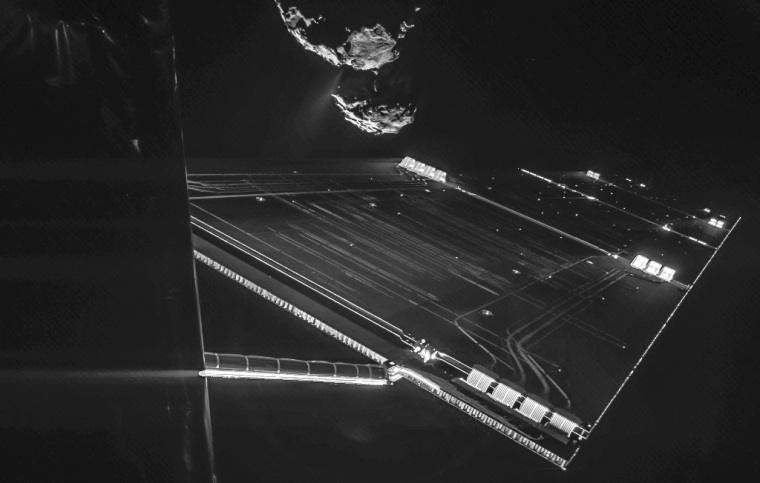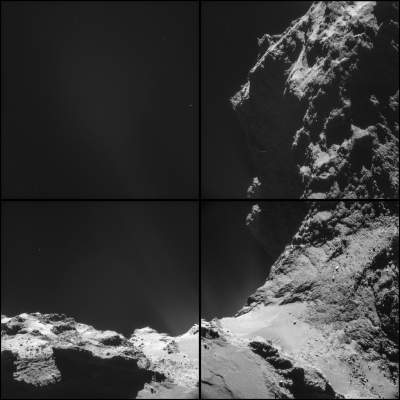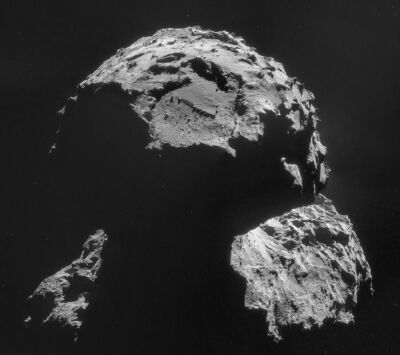Rosetta Philae Landing Probe Latest Update, News: Sleeping Philae, Finally Spotted, Could Still Wake Up
All hope's not lost on comet lander Philae.
After finally spotting the refrigerator-sized probe on comet 67P Churyumov-Gerasminko on Monday, the European Space Agency said there is still a chance that the sleeping robot could continue its epic journey across four billion miles of space.

This will happen if it reawakens in the coming weeks or months as the comet flies closer to the Sun. More sunlight means more energy to recharge the lander's batteries, said Dr. Stephan Ulamec, the Rosetta mission's Philae Lander Manager at the DLR German Aerospace Center in Darmstadt, Germany.
The comet – and Philae, together with its mother ship Rosetta – will reach their closest point to the Sun on Aug.13 next year at a distance of about 115 million miles, roughly between the orbits of Earth and Mars.
Mission control lost contact with Philae on Saturday when Rosetta flew below the comet's horizon.
In the meantime, focus is now on the mother ship, which is maneuvering back into the comet's orbit after dropping off Philae.
Next year, as the comet becomes more active as it approaches the Sun, ESA officials said Rosetta will fly unbound "orbits," making brief fly-bys to within five miles of the comet's surface.
On Monday, ESA scientists announced that they have finally spotted Philae on comet 67P Churyumov-Gerasminko based on the images taken and relayed by Rosetta.
Although the robot is barely visible in the pictures, a faint glint and shadow can be seen indicating the spot where it landed after it bounced off from its original landing site. Two harpoons that were supposed to anchor the probe to the ground failed to deploy, causing Philae to bounce half a mile back into space after its initial touchdown.
The latest images confirmed that the probe finally settled in the shadow of a crater wall where its solar panels could not absorb enough energy from sunlight.
Meanwhile, ESA has released mind-blowing close-up images of comet 67P taken by Rosetta and Philae before and after the comet landing. The images have been given Creative Commons license which means the public is free to share and use them.






 Christians don't have to affirm transgenderism, but they can’t express that view at work: tribunal
Christians don't have to affirm transgenderism, but they can’t express that view at work: tribunal Archaeology discovery: Medieval Christian prayer beads found on Holy Island
Archaeology discovery: Medieval Christian prayer beads found on Holy Island Presbyterian Church in America votes to leave National Association of Evangelicals
Presbyterian Church in America votes to leave National Association of Evangelicals Over 50 killed in 'vile and satanic' attack at Nigerian church on Pentecost Sunday
Over 50 killed in 'vile and satanic' attack at Nigerian church on Pentecost Sunday Ukrainian Orthodox Church severs ties with Moscow over Patriarch Kirill's support for Putin's war
Ukrainian Orthodox Church severs ties with Moscow over Patriarch Kirill's support for Putin's war Islamic State kills 20 Nigerian Christians as revenge for US airstrike
Islamic State kills 20 Nigerian Christians as revenge for US airstrike Man who served 33 years in prison for murder leads inmates to Christ
Man who served 33 years in prison for murder leads inmates to Christ


 Nigerian student beaten to death, body burned over ‘blasphemous’ WhatsApp message
Nigerian student beaten to death, body burned over ‘blasphemous’ WhatsApp message 'A new low': World reacts after Hong Kong arrests 90-year-old Cardinal Joseph Zen
'A new low': World reacts after Hong Kong arrests 90-year-old Cardinal Joseph Zen Iran sentences Christian man to 10 years in prison for hosting house church worship gathering
Iran sentences Christian man to 10 years in prison for hosting house church worship gathering French Guyana: Pastor shot dead, church set on fire after meeting delegation of Evangelicals
French Guyana: Pastor shot dead, church set on fire after meeting delegation of Evangelicals ‘Talking Jesus’ report finds only 6% of UK adults identify as practicing Christians
‘Talking Jesus’ report finds only 6% of UK adults identify as practicing Christians Mission Eurasia ministry center blown up in Ukraine, hundreds of Bibles destroyed: 'God will provide'
Mission Eurasia ministry center blown up in Ukraine, hundreds of Bibles destroyed: 'God will provide' Church holds service for first time after ISIS desecrated it 8 years ago
Church holds service for first time after ISIS desecrated it 8 years ago Burger King apologizes for 'offensive campaign' using Jesus' words at the Last Supper
Burger King apologizes for 'offensive campaign' using Jesus' words at the Last Supper Uganda: Muslims abduct teacher, burn him inside mosque for praying in Christ’s name
Uganda: Muslims abduct teacher, burn him inside mosque for praying in Christ’s name